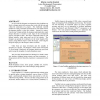Free Online Productivity Tools
i2Speak
i2Symbol
i2OCR
iTex2Img
iWeb2Print
iWeb2Shot
i2Type
iPdf2Split
iPdf2Merge
i2Bopomofo
i2Arabic
i2Style
i2Image
i2PDF
iLatex2Rtf
Sci2ools
ACMDIS
2000
ACM
2000
ACM
Just-in-Time Design in a Fast-Paced Product Group
In real world development environments where deadlines are fixed, a designer must craft a process that works with the team and within the constraints of a project. The traditional waterfall method of writing a detailed specification for each feature before development begins is often not realistic. Instead, by using a “just-in-time” design method, the designer understands how much design direction is needed at each stage of the development process, and delivers that. The larger components must be well defined initially, while other parts can be left sketchy. The designer can spread the workload over the entire length of the project, using different steps to refine the design. Delivering the design in stages gives the design a chance to mature. Often there are many developers and few (usually 1) designers on a project. The designer is often on the critical path. To avoid being a bottleneck, the designer should use good tools and leverage the strengths of a multi-disciplinary team. ...
ACMDIS 2000 | Designers | Human Computer Interaction | Multi-disciplinary Teams | Traditional Waterfall Method |
| Added | 01 Aug 2010 |
| Updated | 01 Aug 2010 |
| Type | Conference |
| Year | 2000 |
| Where | ACMDIS |
| Authors | Margo Lustig Ezekiel |
Comments (0)

